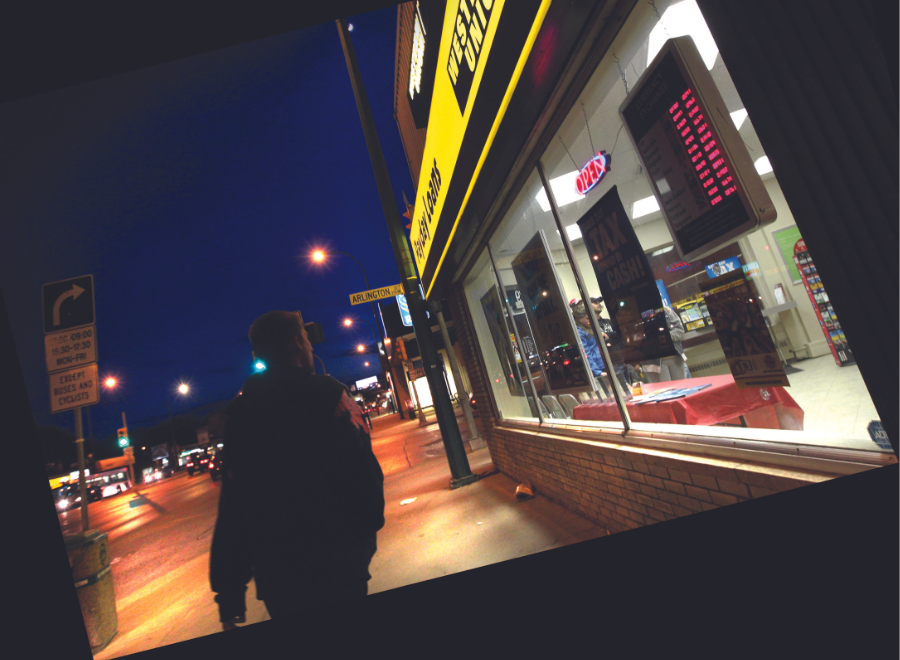“Don’t got picture ID, but I got all my other ID.” Baseball cap perched on his head and tattoos on his neck, the young man hands over his cheque to the cashier at the variety store. The cashier jokes with the customer, checks his ID, takes his thumbprint and points up: “Look at the camera. We’re going to take your photo.”
Cashing a cheque here is fast and friendly, letting customers walk out the door with cash in hand, but this mom-and-pop convenience store in Winnipeg’s North End doesn’t offer all the services of a regular bank. Unless he has a bank account, the tattooed young man will find it harder to get a money order to rent an apartment, to keep a job where the boss insists on paying through direct deposit, to develop a credit history, to get a car loan, to open a savings account or to start a Registered Education Savings Plan (RESP) for a child.
You may unsubscribe from any of our newsletters at any time.
These are some of the problems faced by the three percent of Canadians who don’t have a bank account, according to a 2005 survey sponsored by the Financial Consumer Agency of Canada. These “unbanked” citizens, who are more likely to be low-income earners, tend to turn to convenient but costly alternative financial services like pawnshops, payday loan lenders, instant tax-refund companies or the more than 900 Money Mart and Cash Store outlets throughout Canada. On impoverished streets across the country, these fringe services are becoming ever more common, suggesting that Canada’s banking system is failing those in need. What’s extraordinary, though, is how Winnipeggers fought back when 15 out of 20 bank branches closed in the city’s poorest neighbourhood.
Cut off by the railroad tracks from Winnipeg’s downtown, the North End is a tough, proud community, home to successive waves of migrants who moved to the city for a better life. A walk through the neighbourhood reveals stores selling Ukrainian handicrafts, murals of ceremonial pipes and eagles, social service agencies, and a sign at the Children of the Earth high school announcing the spring feast and pipe ceremony. Over the years, the area’s population has shifted from Eastern European immigrants to Indigenous people from Manitoba’s northern reserves. In the 1980s and ’90s, the banks closed their branches, and over a dozen fringe financial service providers moved in — pawnshops, cheque-cashing companies, rent-to-own stores and payday loan operations.
The situation is comparable in other Canadian cities. Bank branches are scarce in low-income inner-city neighbourhoods like Parkdale in Toronto and the Downtown Eastside in Vancouver. And although Canada’s five major banks earned record profits in 2011, they may be reluctant to open a branch in a poor neighbourhood that loses money or earns a lower profit.
A response to the problems of Winnipeg’s underbanked people started with one minister’s outrage at the high profits being pulled in by banks. In 1996, Lynda Trono was working at the United Church’s Manitoba and Northwestern Ontario Conference. “There used to be a poster on the wall in the Conference office that had all the salaries that the CEOs made at the multinational corporations,” she says. “I did some analysis of the difference in the salary between the average bank employee and the CEO. It just wasn’t fair.” Trono brought together people with both finance experience and a social justice bent — both head and heart — and the Alternative Financial Services Coalition was born. The group’s initial project was a community needs assessment of the North End.
One of the first to join the coalition was Verna McKay, then the minister of the North End Stella, a community ministry of the United Church. McKay knew first-hand the challenges of living in the North End. “Often Aboriginal people have a particularly hard time in the banks. The tellers are stickier about the rules,” she says. Besides the racism, poor people tend to move frequently and lack updated identification; after the banks left, North End residents needed bus fare and time to go to a real bank.
The Alternative Financial Services Coalition and its allies met regularly over the years, and included North End residents, the Mennonite Central Committee, other community ministries, local politicians, academics and social service agencies. The group discussed blue-sky ideas like a United Church credit union, an ethical pawnshop and a computer training program. Slowly, concrete programs sprang up: volunteers helped people fill out their income tax forms. The Supporting Employment and Economic Development (SEED) social service agency offered a financial literacy course that incorporated Indigenous teachings.
Savings programs also offered residents friendly encouragement to sock away funds. At the North End Stella, “the savings circle used to meet up on the third floor, in the sanctuary,” says McKay. She smiles as she gestures upstairs in the historic building, a church that has been serving the North End for over 100 years. Savings were doubled by matching grants, giving participants an incentive to save for goals: a washing machine, dentures or a badly needed new pair of glasses. “People who had never saved [before] never thought they could save,” says McKay. “One woman bought a bunk bed for her five-year-old son, and then he could have a sleepover.”
In 2006, the coalition joined forces with the Assiniboine Credit Union and the North End Renewal Corporation (a local development agency) to develop a financial clinic offering basic bank services to residents. Over the next five years, the Community Financial Services Centre allowed low-income people to open accounts and deposit cheques. And the pilot program helped the Assiniboine Credit Union fine-tune its business plan for a new branch: for once, a bank would be opening in the North End, not leaving.
At the North End’s largest pawnshop, Chochy’s, staff buzz in shoppers looking for bargains among the TV sets, jewelry and power tools. Norm Glass, the shop’s owner and the leader of a local pawnbroker’s association, says the banks moved out of the area because the demographics changed. More residents were on welfare, and the banks made less profit on people’s accounts. “The banks aren’t doing it for the public. They’re just a pawnshop, just a massive pawnshop,” says Glass.
In low-income neighbourhoods, Canadians may turn to alternative banking services because they like the friendly staff, convenient hours and location. Also, fees are paid up front rather than coming as an unpleasant surprise at the end of the month.
Customer demand means the cheque-cashing business is expanding, with 576 branches of the Cash Store across Canada. “A lot of people just feel disenfranchised by traditional institutions. It’s that simple. People want a different option,” says Michael Thompson, senior vice-president of Cash Store Financial. He lauds his company’s customer service, convenient evening and weekend hours, and open-concept stores that invite customers to sit. In partnership with DirectCash Bank, the Cash Store offers a flat-fee bank account that allows outlets to build a long-term relationship with customers. Thompson argues that the average payday loan company makes substantially less than any bank in Canada. “It’s administrative costs. It takes 15 to 20 minutes to arrange a payday loan. But for a bank, a line of credit could be arranged in 15 minutes, and that relationship could last for years.”
Despite the customer friendliness, the service fees add up at alternative finance providers: a person on social assistance might pay $200 to $300 a year to cash their cheques, more expensive than the Royal Bank’s basic account at $4 monthly or $48 annually.
Academic Jerry Buckland, a professor of international development at the Canadian Mennonite University in Winnipeg, has studied what draws people to alternative financial services. “Fringe services really offer services meeting the needs of poor people,” he says. On the other hand, he argues that relying on alternative financial services is a dead end: “You won’t learn about other financial services, ways to save and how to build your credit rating.”
Buckland’s new book, Hard Choices: Financial Exclusion, Fringe Banks, and Poverty in Urban Canada, criticizes a two-tier banking system that charges high fees to low-income people for low-quality services while middle-income people pay low fees for high-quality services. He says the solution is to provide good banking services to everyone.
Buckland finds hope in community banking projects intended to reach the poor, some the result of banks partnering with community organizations to open banks in low-income areas, offering basic services like a deposit account and low-cost cheque cashing. The Royal Bank of Canada has opened two outlets of Cash & Save in Toronto’s Parkdale and Regent Park neighbourhoods. In Vancouver, Vancity Credit Union and the Portland Hotel Community Services Society opened Pigeon Park Savings in the heart of the Downtown Eastside. In Quebec, the Desjardins Mutual Assistance Fund operates in 28 locations of the province’s caisses populaires, offering access to small emergency loans.
Another possible solution is to reform mainstream banks to make it easier for low-income Canadians to use their services, either through self-regulation by the industry or government oversight. Canadian banks have voluntarily agreed to offer a basic bank account for a low fee, and some have made their ATMs more accessible to people who use wheelchairs. Meanwhile, in March 2012 the federal government changed the rules that allow banks to hold cheques for a week without releasing the cash, a move that means low-income people will see the money sooner when they deposit cheques, lessening the temptation to visit a cheque-cashing outfit.
The culmination of the efforts of Winnipeggers like Trono and McKay stands in a one-storey red brick building across from a community centre, a short walk away from the pawnshops. In January 2012, the Assiniboine Credit Union opened a new branch on McGregor Street specifically to serve the North End community. Inside a former Royal Bank branch, it offers an ATM, a night deposit box for businesses, and a lounge where customers wait for appointments to discuss their mortgage.
Trim and serious in a black suit and tie, branch manager Brent Differ says the new credit union has been warmly welcomed by the community. In the few months since the branch launched, he has opened up more RESPs here than at any other branch he’s worked at. “It’s a close-knit community, and information travels by word of mouth. People hear their neighbour opened an RESP, and then they want to do it,” says Differ. “In this community, they want to make sure their children have good futures.”
The new branch of the credit union operates as a business, not a charity. It turns a profit — proof that business sense can align with a sense of social responsibility. While cashing a cheque at a variety store is a convenient short-term fix, it papers over the hole left in a neighbourhood when a bank closes. Luckily, the residents of Winnipeg’s North End banded together to demand a better future. From early blue-sky thinking to a red brick branch, the credit union shows what can happen when head and heart work together.
***
This story first appeared in The United Church Observer’s June 2012 issue with the title “Where Credit’s Due.”














